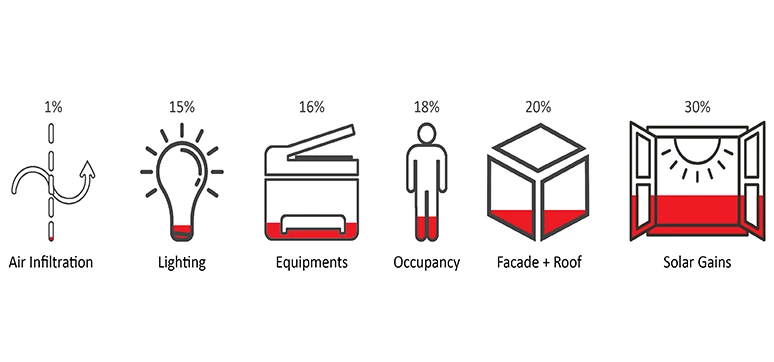Building operation accounts for 30% of global energy consumption and 26% of global energy-related emissions according to Buildings – Energy Systems – IEA (n.d.). Commercial and residential buildings consume about 33% of the energy for cooling and daylighting in India (Kumar et al., 2017). Due to such significant contributions to negative phenomena like increasing carbon emissions, rising global temperatures, and climate change, optimizing building energy performance has become a matter of utmost importance as a corrective measure.
In fine-tuning a building’s energy use, looking at customized climate-responsive design solutions that reduce building energy demand, also called passive design, becomes crucial. Passive design is as important, sometimes more, as deploying efficiently-performing air- air-conditioning and ventilation systems. Passive design involves parametric analysis considering the element-wise contribution to the building heating/ cooling demands. The critical aspect of passive design is the building envelope that separates the building’s conditioned and unconditioned environment.
ROLE OF FAÇADE DESIGN IN ENERGY EFFICIENCY
Building performance simulations (BPS) reveal that the envelope, comprising the building façade and the roof, contributes 50% to the cooling demand for a college building in Kolkata, India. A lower cooling demand implies a lower HVAC system sizing and energy consumption. Thus, the building must have an energy-efficient façade, as its significance is high on the building’s energy performance and occupant thermal comfort. (As shown in Figure 1).
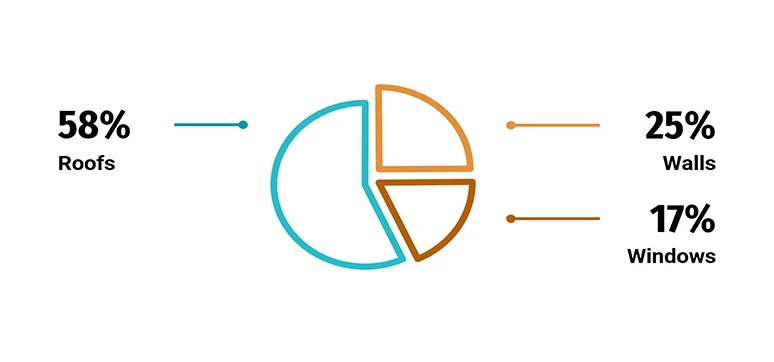
KEY PARAMETERS FOR AN ENERGY- EFFICIENT FAÇADE
Various parameters must be addressed for a façade design to be considered energy-efficient. As all buildings are different, these parameters need tweaking based on the climate zone, construction type, and space conditioning needs. Factors, along with their impacts, that are taken into consideration while designing a façade are:
- Thermal Insulation: The thermal insulation of a façade directly translates to the reduction in heat transfer in the building. A higher insulation provides more delay in the rate of conductive heat gains for the building. This results in lower energy consumption for maintaining a thermally comfortable environment. The thermal insulation performance of a material, wall, or window assembly is expressed in terms of its thermal resistance, or R-value. The mathematical inverse of the R-value is the U-value, or the thermal transmittance, another commonly used metric to understand the heat transfer rate. (Figure 2 shows the break-up of the façade heat gains/cooling demand in Figure 1).
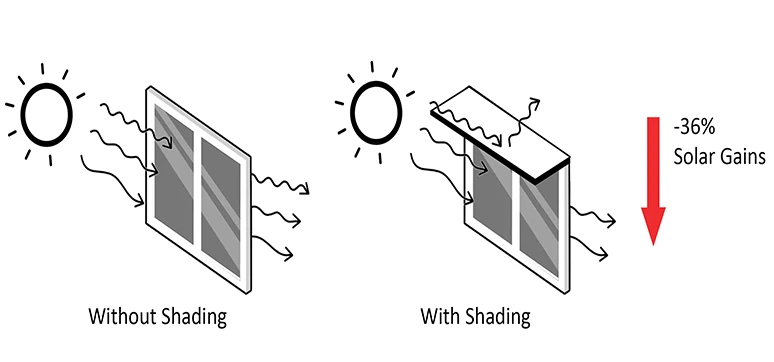
- Window Glass Optimisation and Daylighting: Unlike walls, it is not enough to only thermally insulate the windows to expect a reduction in heat transfer, as windows also bring in heat via radiation and not only conduction. The window-to-wall ratio (WWR) should be well thought out, and the window glass needs to be optimised in terms of its solar heat gain coefficient (SHGC) and visible light transmittance (VLT) values to ensure that daylight ingress is adequate while the radiative heat gain component is low. Modern products such as low-e coating glass and high-performance glazing offer optimised glass for energy-efficient buildings.
-
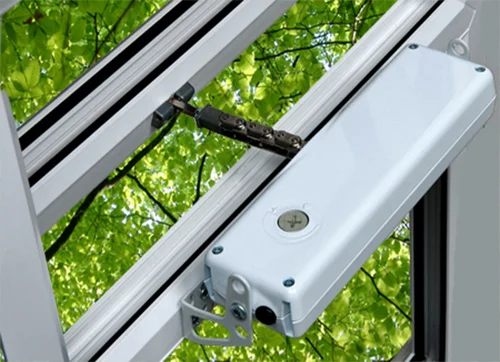
Figure 4: Window fitted with a motorised actuato Shading Control: Incorporating shading control devices such as horizontal cantilever shades and sidefins adjacent to the windows assists significantly in cutting down the direct component of daylight through the windows. Shading devices thus reduce the radiative heat gains, which is the most significant contributor to the building cooling demand. The importance of shading devices is depicted in Figure 3, which shows an average 36% reduction in radiative heat gains by adding a horizontal shading device on the south façade. Products such as automated blinds and shades can further help in reducing glare hotspots and visual discomfort.
- Thermal Mass: The presence of materials with high thermal mass in the building façade helps offset heat gains as the thermal mass stores the heat equivalent to its heat capacity. This stored heat creates a thermal lag, serving as a natural temperature buffer, reducing the building’s reliance on mechanical cooling systems and contributing to improved energy efficiency and occupant comfort.
- Material Selection and SRI: The materials used in the façade, such as claddings and paints, have a significant impact on the energy performance of the building. Reflective materials and low- emissivity coatings can minimise heat absorption and heat transfer, respectively, by direct radiation. The reflectivity of a surface can be determined by its solar reflectance index (SRI). The practice of employing high-SRI white paint on rooftops, commonly referred to as cool roofs, is on the rise due to its low-cost and highly effective approach for mitigating heat gain through the roof surface, which accounts for 58% of the conductive heat gains for the building in Figure 2.
- Airtightness: A well-designed façade should ensure airtightness to prevent air leakage. Air leaks can lead to energy wastage, as heating or cooling systems must work harder to maintain a consistent indoor temperature.
- Natural/Mixed Mode Ventilation: Façade design should incorporate elements that facilitate natural or mixed mode ventilation. Well-placed windows, louvers, or vents can promote the circulation of fresh air, reducing the reliance on mechanical ventilation systems, and at times when the ambient conditions are favourable, can reduce the reliance on air-conditioning systems as well. This not only saves energy but also enhances indoor air quality. The automated control of windows is necessary for efficient window operation, and it can be achieved through smart window actuators, remote control systems, and CO2 and air quality sensors.
- Renewable Energy Integration: With the advent of glass with integrated solar cells, known as photovoltaic glass, façades can now integrate renewable energy for enhanced energy efficiency and reduced carbon emissions.
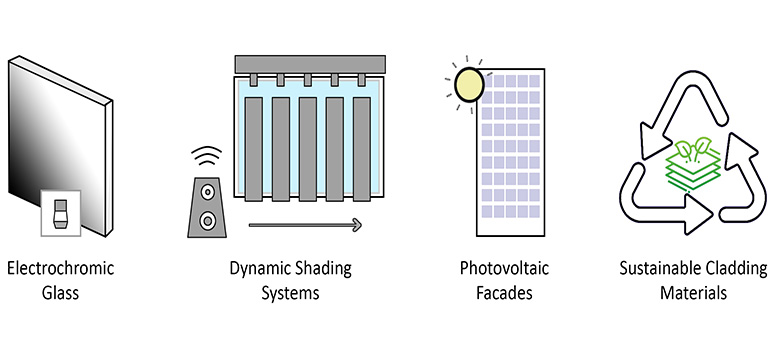
INNOVATIVE PRODUCTS FOR ENERGY- EFFICIENT FAÇADES
Technological innovation in façade design has resulted in products that aid building energy performance. Prominent examples of such products are listed here.
- Electrochromic glass: Electrochroglass, commonly called smart glass, can change its transparency or opacity in response to electricity. It has a polymer dispersed liquid crystal (PDLC) filling, in which the liquid crystals align when electricity is applied and make the glass clear or transparent, and get scattered when power is turned off and render the glass as opaque or translucent.
- Dynamic shading systems: Dynamic shading systems comprise automatic motorised blinds, shades, and louvers that automatically adjust their positions based on programmed schedules or changing lighting and temperature.
- Photovoltaic façades: PV integrated façades consist of solar panels or cladding materials incorporated into the glazing. This reduces energy costs and contributes to renewable energy generation and carbon emission reduction. These systems are also called Building Integrated Photovoltaic (BIPV) systems.
- Sustainable cladding materials: Looking at the entire lifecycle of a material as part of the whole building design approach, bio-based materials are being incorporated in façade claddings to minimise environmental impact.
REFERENCES
Buildings – Energy System – IEA. (n.d.). Retrieved October 18, 2023, from https://www.iea.org/ energy-system/buildings#programmes
Kumar, G. K., Saboor, S., & Babu, T. P. A. (2017). Study of Various Glass Window and Building Wall Materials in Different Climatic Zones of India for Energy Efficient Building Construction. Energy Procedia, 138(December), 580–585.
